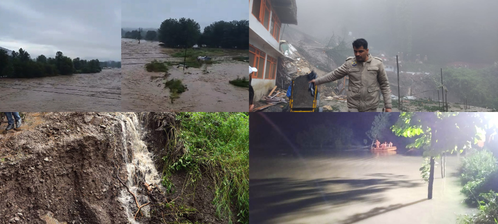Shimla: As Himachal Pradesh is battling the worst natural calamity in 50 years, civil society organizations and environmental activists have urged Prime Minister Narendra Modi to consider declaration of the situation as a national disaster or calamity of rare severity under the provisions of the Disaster Management Act of 2005.

In a missive to the Prime Minister, they said the state is currently grappling with an unprecedented disaster scenario.
For the past month, more than half of the population has been living under constant life threats due to heavy rainfall, floods, and landslides.
The floods across the Beas Valley were the starting point of this large-scale disaster now unfolding across several districts of the state, they said.
Thousands of buildings have been destroyed partially or completely, hundreds of lives lost, and thousands of families forced to abandon their homes, seeking refuge in temporary shelters or with relatives.
The situation is dire, with approximately 2,000 roads severely damaged, and both government and private property suffering significant losses.
Preliminary estimates, they say, suggest that the state is facing a staggering loss of more than Rs 10,000 crore, which is unprecedented.
“In the face of this calamity of rare severity, the state of Himachal Pradesh is struggling to mitigate the situation without the required support from the Central government, which might lead to delay in instant aid and unfairness in the long-term rehabilitation for a large number of families. In this scenario, SDRF funds would not be sufficient to provide quick relief and rehabilitation for people of our state.”
The signatories comprise former bureaucrat R.S. Negi of Him Lok Jagriti Manch in Kinnaur; Kulbhushan Upmanyu of the Himalaya Bachao Samiti Kamla, Chamba; Guman Singh of Himalaya Niti Abhiyan; Deepak Gupta, retired Justice of the Supreme Court; Viplove Thakur, former MP.
As per the State Emergency Operations Centre, the state suffered a loss of Rs 7,482 crore from June 24, the onset of the southwest monsoon, till Wednesday.
A total of 327 people lost their lives in the state which witnessed 113 incidents of landsides and 58 flash floods. Thirty-eight people have gone missing in natural calamity-related incidents.
The letter, signed by 89 organizations, comprising a few individuals, points out that taking cues from the stance of the Union Ministry of Home Affairs (MHA), which released only meager funds to assist various states affected by floods, landslides, and cloudburst disaster during 2022, they believe that the intensity and magnitude of disasters in Himachal have far surpassed the state government’s capacity.
The funds for relief and rehabilitation in the current situation at the State Disaster Response Fund (SDRF) level are nearly five percent of the total loss.
Thus there is an urgent need to transfer 100 percent of funds i.e. Rs 10,000 crore of the total damage assessed by the state government directly from the National Disaster Response Fund (NDRF) immediately, and if required from the National Calamity Contingency Fund (NCCF), which would be more appropriate and urgently needed in this grave hour.
Civil society organizations believe the long-term solution to prevent fatal disasters lies through the re-evaluation of development projects and policies in the Himalayan region as serious lessons to be taken for future activities.
“From the perspective of Himalayan communities, this approach can help emphasize the critical nature of the current developmental challenges in Himachal Pradesh and advocate for a more resilient and sustainable path forward,” they argue.
Cloudbursts and flash floods have become a regular feature in the hill state of Himachal Pradesh in recent years. The heavy loss of life caused by such calamities can be mainly attributed to increasing human activity, particularly along the rivers and water channels.
The local authorities are yet to wake up from their slumber despite the fact that most of the picnic spots in the Himalayan state fall in high seismic zones IV-V, suggesting severest seismic sensitivity.
Advocating sustainable development, the National Green Tribunal and the state High Court have time and again rapped the state authorities over their lack of response to the growing unauthorized constructions across Himachal.
Old-timers charge the successive BJP and Congress governments with converting most of the picturesque towns into concrete jungles. In Sanjauli, a congested locality on Shimla’s outskirts, the dead often have to be lifted out of their homes with ropes.
Courtesy: “IANS”
The opinions, beliefs and viewpoints expressed by authors, news service providers on this page do not necessarily reflect the opinions, beliefs and viewpoints of Hill Post. Any views or opinions are not intended to malign any religion, ethnic group, club, organization, company, or individual.
Hill Post makes no representations as to the accuracy or completeness of any information on this site page.


